Moddie Developer Guide
Acknowledgements
{ list here sources of all reused/adapted ideas, code, documentation, and third-party libraries -- include links to the original source as well }
Setting up, getting started
Refer to the guide Setting up and getting started.
Design
Architecture

The Architecture Diagram given above explains the high-level design of the App.
Given below is a quick overview of main components and how they interact with each other.
Main components of the architecture
Main (consisting of classes Main and MainApp) is in charge of the app launch and shut down.
- At app launch, it initializes the other components in the correct sequence, and connects them up with each other.
- At shut down, it shuts down the other components and invokes cleanup methods where necessary.
The bulk of the app's work is done by the following four components:
UI: The UI of the App.Logic: The command executor.Model: Holds the data of the App in memory.Storage: Reads data from, and writes data to, the hard disk.
Commons represents a collection of classes used by multiple other components.
How the architecture components interact with each other
The Sequence Diagram below shows how the components interact with each other for the scenario where the user issues the command delete 1.

Each of the four main components (also shown in the diagram above),
- defines its API in an
interfacewith the same name as the Component. - implements its functionality using a concrete
{Component Name}Managerclass (which follows the corresponding APIinterfacementioned in the previous point.
For example, the Logic component defines its API in the Logic.java interface and implements its functionality using the LogicManager.java class which follows the Logic interface. Other components interact with a given component through its interface rather than the concrete class (reason: to prevent outside component's being coupled to the implementation of a component), as illustrated in the (partial) class diagram below.

The sections below give more details of each component.
UI component
The API of this component is specified in Ui.java

The UI consists of a MainWindow that is made up of parts e.g.CommandBox, ResultDisplay, PersonListPanel, StatusBarFooter etc. All these, including the MainWindow, inherit from the abstract UiPart class which captures the commonalities between classes that represent parts of the visible GUI.
The UI component uses the JavaFx UI framework. The layout of these UI parts are defined in matching .fxml files that are in the src/main/resources/view folder. For example, the layout of the MainWindow is specified in MainWindow.fxml
The UI component,
- executes user commands using the
Logiccomponent. - listens for changes to
Modeldata so that the UI can be updated with the modified data. - keeps a reference to the
Logiccomponent, because theUIrelies on theLogicto execute commands. - depends on some classes in the
Modelcomponent, as it displaysPersonobject residing in theModel.
Logic component
API : Logic.java
Here's a (partial) class diagram of the Logic component:

The sequence diagram below illustrates the interactions within the Logic component, taking execute("delete 1") API call as an example.
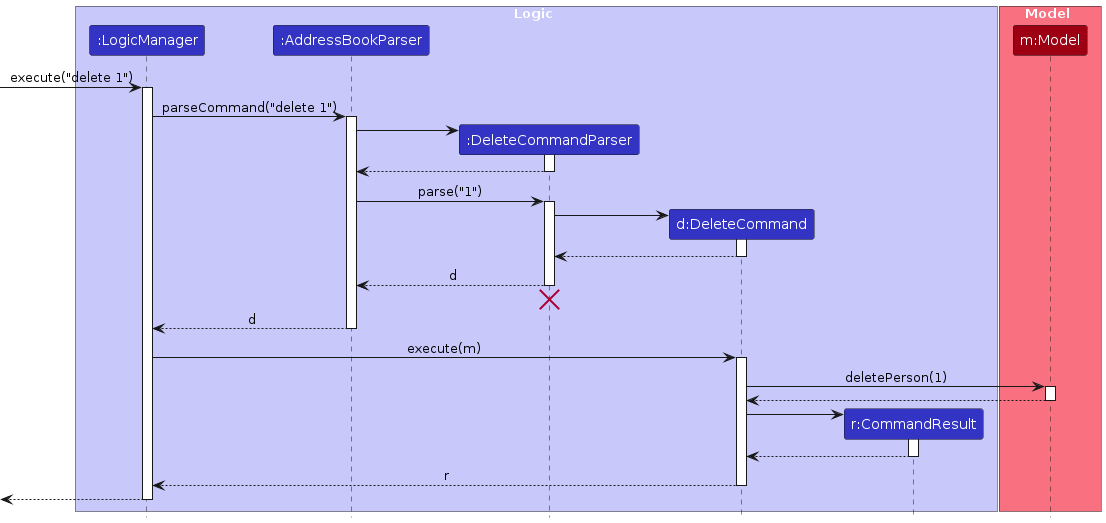
Note: The lifeline for DeleteCommandParser should end at the destroy marker (X) but due to a limitation of PlantUML, the lifeline continues till the end of diagram.
How the Logic component works:
- When
Logicis called upon to execute a command, it is passed to anAddressBookParserobject which in turn creates a parser that matches the command (e.g.,DeleteCommandParser) and uses it to parse the command. - This results in a
Commandobject (more precisely, an object of one of its subclasses e.g.,DeleteCommand) which is executed by theLogicManager. - The command can communicate with the
Modelwhen it is executed (e.g. to delete a person).
Note that although this is shown as a single step in the diagram above (for simplicity), in the code it can take several interactions (between the command object and theModel) to achieve. - The result of the command execution is encapsulated as a
CommandResultobject which is returned back fromLogic.
Here are the other classes in Logic (omitted from the class diagram above) that are used for parsing a user command:

How the parsing works:
- When called upon to parse a user command, the
AddressBookParserclass creates anXYZCommandParser(XYZis a placeholder for the specific command name e.g.,AddCommandParser) which uses the other classes shown above to parse the user command and create aXYZCommandobject (e.g.,AddCommand) which theAddressBookParserreturns back as aCommandobject. - All
XYZCommandParserclasses (e.g.,AddCommandParser,DeleteCommandParser, ...) inherit from theParserinterface so that they can be treated similarly where possible e.g, during testing.
Model component
API : Model.java

The Model component,
- stores the address book data i.e., all
Personobjects (which are contained in aUniquePersonListobject). - stores the currently 'selected'
Personobjects (e.g., results of a search query) as a separate filtered list which is exposed to outsiders as an unmodifiableObservableList<Person>that can be 'observed' e.g. the UI can be bound to this list so that the UI automatically updates when the data in the list change. - stores a
UserPrefobject that represents the user’s preferences. This is exposed to the outside as aReadOnlyUserPrefobjects. - does not depend on any of the other three components (as the
Modelrepresents data entities of the domain, they should make sense on their own without depending on other components)
Note: An alternative (arguably, a more OOP) model is given below. It has a Tag list in the AddressBook, which Person references. This allows AddressBook to only require one Tag object per unique tag, instead of each Person needing their own Tag objects.
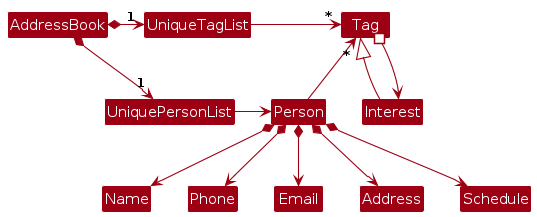
Storage component
API : Storage.java

The Storage component,
- can save both address book data and user preference data in JSON format, and read them back into corresponding objects.
- inherits from both
AddressBookStorageandUserPrefStorage, which means it can be treated as either one (if only the functionality of only one is needed). - depends on some classes in the
Modelcomponent (because theStoragecomponent's job is to save/retrieve objects that belong to theModel)
Common classes
Classes used by multiple components are in the seedu.addressbook.commons package.
Implementation
This section describes some noteworthy details on how certain features are implemented.
Add Schedule feature
The following sequence diagram shows how an add schedule operation goes through the Logic component:

The following activity diagram summarizes what happens when a user executes the addSched command:
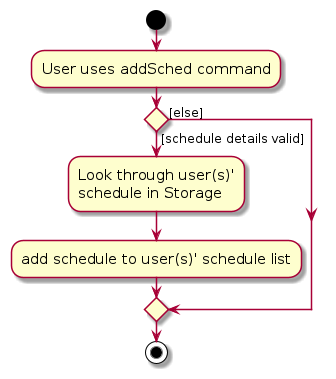
Edit Schedule feature
The following sequence diagram shows how an add schedule operation goes through the Logic component:
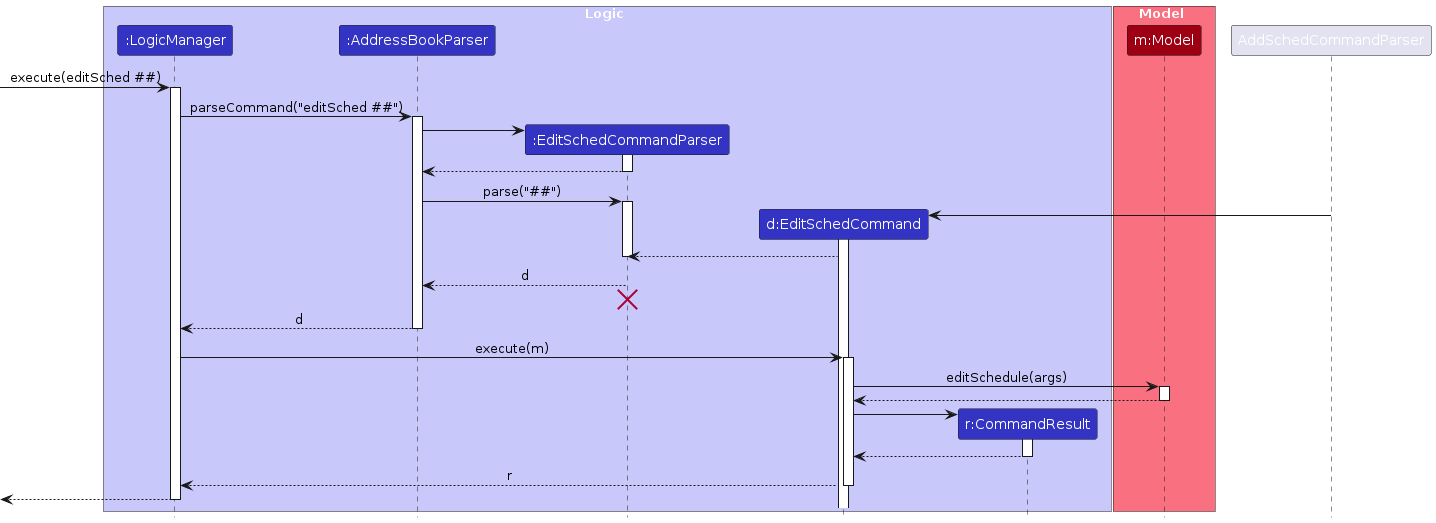
The following activity diagram summarizes what happens when a user executes the editSched command:
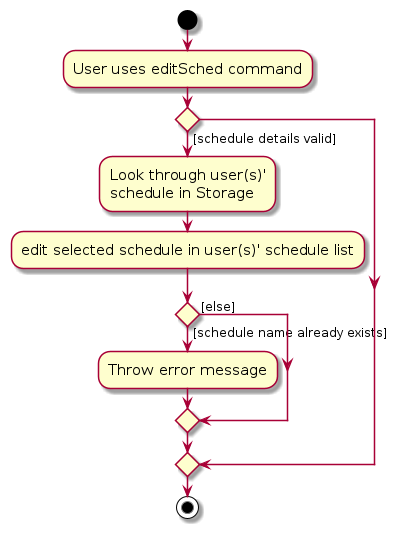
Delete Schedule feature
The following sequence diagram shows how an add schedule operation goes through the Logic component:
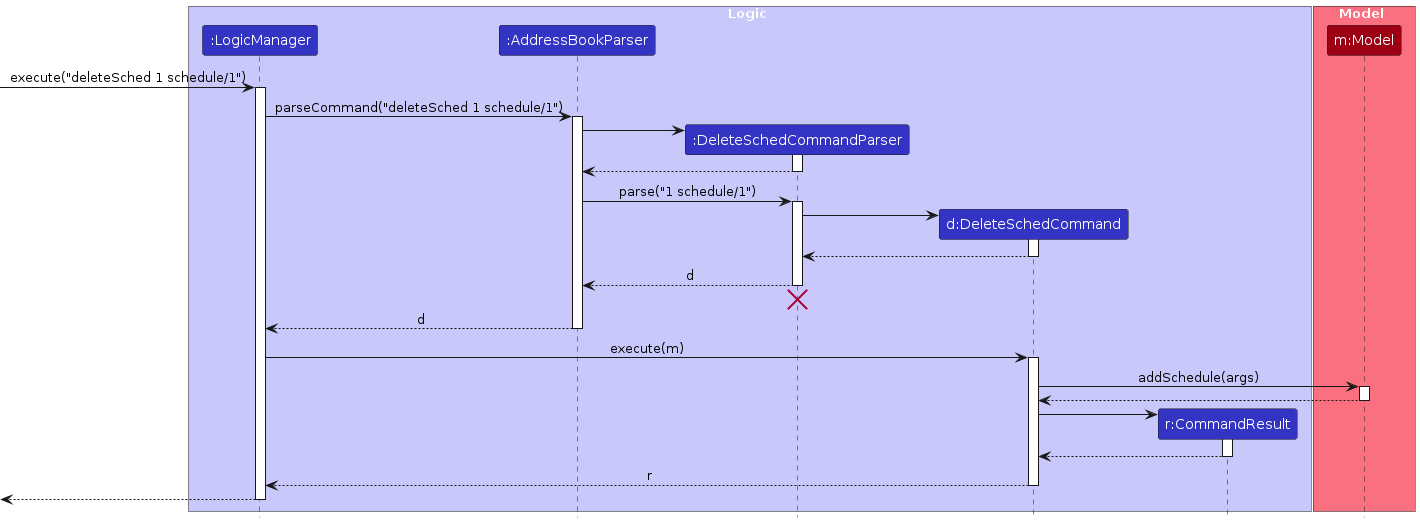
The following activity diagram summarizes what happens when a user executes the deleteSched command:
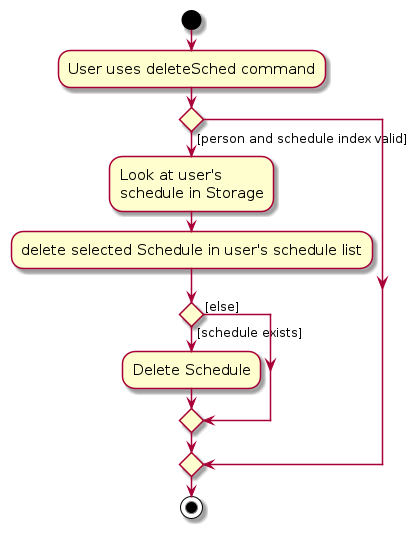
[Proposed] Undo/redo feature
Proposed Implementation
The proposed undo/redo mechanism is facilitated by VersionedAddressBook. It extends AddressBook with an undo/redo history, stored internally as an addressBookStateList and currentStatePointer. Additionally, it implements the following operations:
VersionedAddressBook#commit()— Saves the current address book state in its history.VersionedAddressBook#undo()— Restores the previous address book state from its history.VersionedAddressBook#redo()— Restores a previously undone address book state from its history.
These operations are exposed in the Model interface as Model#commitAddressBook(), Model#undoAddressBook() and Model#redoAddressBook() respectively.
Given below is an example usage scenario and how the undo/redo mechanism behaves at each step.
Step 1. The user launches the application for the first time. The VersionedAddressBook will be initialized with the initial address book state, and the currentStatePointer pointing to that single address book state.
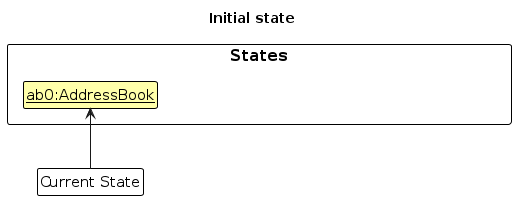
Step 2. The user executes delete 5 command to delete the 5th person in the address book. The delete command calls Model#commitAddressBook(), causing the modified state of the address book after the delete 5 command executes to be saved in the addressBookStateList, and the currentStatePointer is shifted to the newly inserted address book state.
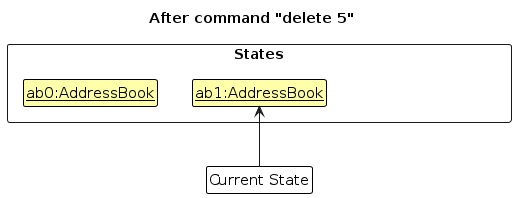
Step 3. The user executes add n/David … to add a new person. The add command also calls Model#commitAddressBook(), causing another modified address book state to be saved into the addressBookStateList.
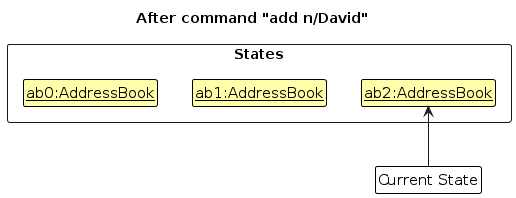
Note: If a command fails its execution, it will not call Model#commitAddressBook(), so the address book state will not be saved into the addressBookStateList.
Step 4. The user now decides that adding the person was a mistake, and decides to undo that action by executing the undo command. The undo command will call Model#undoAddressBook(), which will shift the currentStatePointer once to the left, pointing it to the previous address book state, and restores the address book to that state.

Note: If the currentStatePointer is at index 0, pointing to the initial AddressBook state, then there are no previous AddressBook states to restore. The undo command uses Model#canUndoAddressBook() to check if this is the case. If so, it will return an error to the user rather
than attempting to perform the undo.
The following sequence diagram shows how an undo operation goes through the Logic component:
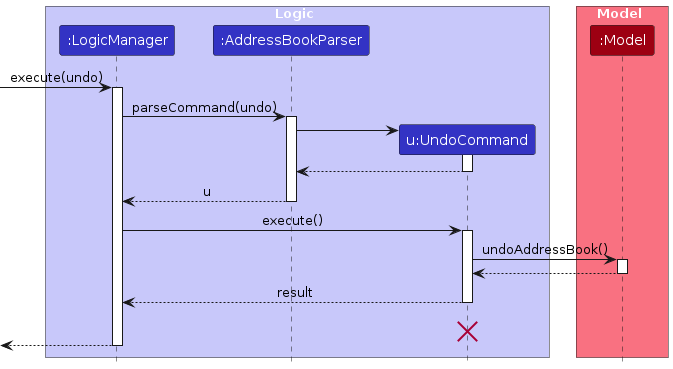
Note: The lifeline for UndoCommand should end at the destroy marker (X) but due to a limitation of PlantUML, the lifeline reaches the end of diagram.
Similarly, how an undo operation goes through the Model component is shown below:
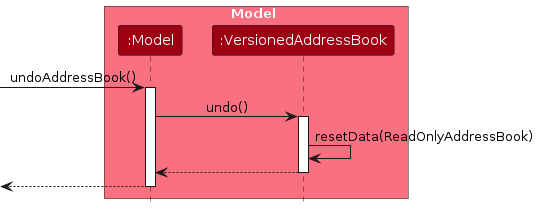
The redo command does the opposite — it calls Model#redoAddressBook(), which shifts the currentStatePointer once to the right, pointing to the previously undone state, and restores the address book to that state.
Note: If the currentStatePointer is at index addressBookStateList.size() - 1, pointing to the latest address book state, then there are no undone AddressBook states to restore. The redo command uses Model#canRedoAddressBook() to check if this is the case. If so, it will return an error to the user rather than attempting to perform the redo.
Step 5. The user then decides to execute the command list. Commands that do not modify the address book, such as list, will usually not call Model#commitAddressBook(), Model#undoAddressBook() or Model#redoAddressBook(). Thus, the addressBookStateList remains unchanged.
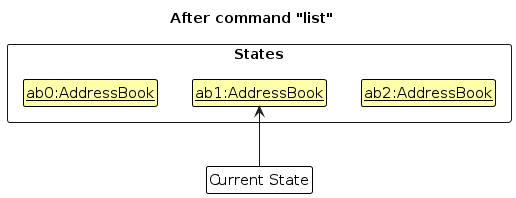
Step 6. The user executes clear, which calls Model#commitAddressBook(). Since the currentStatePointer is not pointing at the end of the addressBookStateList, all address book states after the currentStatePointer will be purged. Reason: It no longer makes sense to redo the add n/David … command. This is the behavior that most modern desktop applications follow.
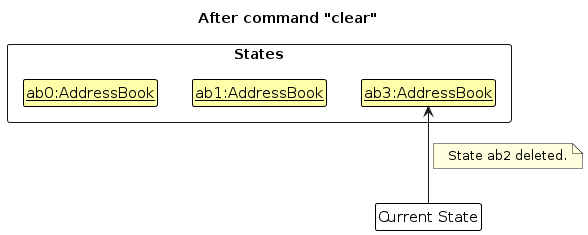
The following activity diagram summarizes what happens when a user executes a new command:
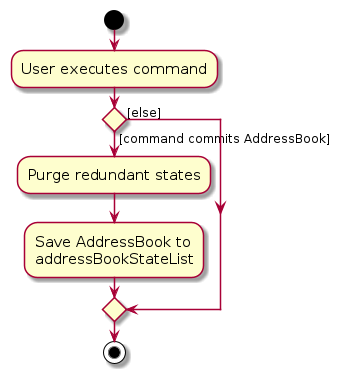
Design considerations:
Aspect: How undo & redo executes:
Alternative 1 (current choice): Saves the entire address book.
- Pros: Easy to implement.
- Cons: May have performance issues in terms of memory usage.
Alternative 2: Individual command knows how to undo/redo by itself.
- Pros: Will use less memory (e.g. for
delete, just save the person being deleted). - Cons: We must ensure that the implementation of each individual command are correct.
- Pros: Will use less memory (e.g. for
{more aspects and alternatives to be added}
[Proposed] Data archiving
{Explain here how the data archiving feature will be implemented}
Documentation, logging, testing, configuration, dev-ops
Appendix: Requirements
Product scope
Target user profile:
- has a need to manage a significant number of contacts
- prefer desktop apps over other types
- can type fast
- prefers typing to mouse interactions
- is reasonably comfortable using CLI apps
- uses application to track schedule of contacts
- prefer a simple UI
Value proposition: manage contacts faster than a typical mouse/GUI driven app
User stories
Priorities: High (must have) - * * *, Medium (nice to have) - * *, Low (unlikely to have) - *
| Priority | As a … | I want to … | So that I can… |
|---|---|---|---|
* * * | busy student | view my friends' schedules | find a suitable time to plan a meetup. |
* * * | NUS student | view my schedule | know what is my plan for the day. |
* * * | NUS student | categorize my friends by interests | quickly identify individuals who share similar hobbies or preferences. |
* * * | NUS student who likes --- | find who has similar hobbies/interests with me | know who might want to go to a --- related activities with me. |
* * * | NUS student who prefers command line interface | have a GUI to include commands | add details with convenience |
* * * | NUS student working part time | utilise Moddie to store contact details for team members, advisor | optimise my time for admin matters and focus on school and work. |
* * * | student project team leader in NUS | check my teammates' schedule | plan an available time for meetings with convenience |
* * * | international NUS student | find local friends that share similar schedules as me to aid me in easing into the university | build meaningful connections, navigate campus life more smoothly. |
* * * | unmotivated student who needs to catch up on my studies | manage my timetable with my friends | easily arrange a study session with them |
* * * | freshman in NUS | find contacts of people with similar interests as myself | get to know them better and make friends. |
* * * | NUS graduate | find my lecturer’s contact email and phone number | ask them to be a reference in my resume when applying for a job. |
* * * | NUS Student | save my friends tagged interest | easily reference and remember their hobbies and preferences. |
* * * | NUS Student | edit my tagged interests | keep my profile updated with my current interests and preferences |
* * * | busy NUS student | easily add my schedule to Moddie | efficiently manage my academic, extracurricular, and personal commitments in one centralized platform. |
* * * | NUS student | delete both my friends' and my own schedule details | maintain privacy and control over the information |
* * * | NUS student | view my friends' and their schedule details | easily coordinate plans, schedule meetings |
* * * | NUS student who gets confused with commands | have an interface to assist me | know what commands I can use |
* * * | NUS student | exit the interface | properly close the application |
* * * | NUS student | clear my commands | clear command messages that I do not need anymore |
* * | NUS graduate | save the contacts of my Lecturer and Tutor | stay in touch with them after graduation. |
* * | NUS student who makes errors | have an interface to prompt me | prevent myself from typing the wrong command. |
* * | NUS student who wants to join extracurricular activities | have a place to store my CCA events | easily make time for them. |
* * | NUS student who would like timetable suggestions | see other people's schedules to see who is taking the same modules as me | see what other modules they are also planning to take in the semester. |
* * | NUS student pursuing an internship | coordinate networking events and informational interviews with local professionals and industry experts | expand my professional network and efficiently manage my academic commitments. |
* * | course coordinator at NUS | communicate announcements, updates, and assignment deadlines to my students | provide a convenient channel for information dissemination and student engagement. |
* * | NUS student | edit my schedule, in case of any changes | ensure that my calendar remains accurate and reflective of my current commitments and availability. |
* | Lecturer | arrange the contacts of the TAs using a module tag | send the correct instructions for the module. |
* | NUS Student | see the schedule and interest of my classmates to know who would share the same interest as me | meet them for outings/lunch. |
* | project leader | have an interface to see the timetable of my group mates | synchronise meetings best fitted for everyone’s schedule. |
* | international student | know my groupmates’ schedules to better arrange my flights (to avoid missing any meeting) | successfully accommodate my travel plans. |
* | introverted NUS student | arrange meetings with my new groupmates without interacting with them | comfortably initiate group collaboration and fulfil project requirements. |
Use cases
(For all use cases below, the System is the Moddie and the Actor is the user, unless specified otherwise)
Use case: UC01 - Add a contact
MSS
User requests to add a contact to the address book.
AddressBook adds the contact.
Use case ends.
Extensions
1a. Format of the entered contact is invalid.
1a1. AddressBook shows an error message: Values not accepted.
Use case ends.
Use case: UC02 - Delete a contact
MSS
User requests to delete a contact in the address book.
AddressBook deletes the contact.
Use case ends.
Extensions
1a. The given index is invalid.
1a1. AddressBook shows an error message: Contact not found in address book.
Use case ends.
Use case: UC03 - Edit a contact
MSS
User requests to edit contact of a specific person in the address book.
AddressBook edits contact information of the specific person.
Use case ends.
Extensions
1a. The given index is invalid.
1a1. AddressBook shows an error message: Contact not found in address book.
Use case ends.
1b. Format of the entered new contact is invalid.
1b1. AddressBook shows an error message: Update values not accepted.
Use case ends.
Use case: UC04 - List all contacts
MSS
User requests to list contacts in the address book.
AddressBook shows the list of all contacts.
Use case ends.
Use case: UC05 - Find contacts of a specific person
MSS
User requests to find a person with the enetred keyword in name.
AddressBook shows founded persons.
Use case ends.
Extensions
1a. The entered keyword is invalid.
- 1a1. AddressBook shows an error message: Values not accepted.
Use case ends.
2a. There is no matched result
- 2a1. AddressBook shows a message: Contacts not found.
Use case ends.
Use case: UC06 - Help
MSS
User requests to read guidance.
AddressBook shows guidance page.
Use case ends.
Use case: UC07 - Exit
MSS
User requests to exit the programme.
AddressBook exits.
Use case ends.
Use case: UC08 - Add schedule
MSS
User requests to add an event with contact from specified date with time.
AddressBook adds the event to the specific contact.
Use case ends.
Extensions
1a. The edited datetime format is invalid
1a1. AddressBook shows an error message: The date format provided is invalid. Format: yyyy-MM-dd HH:mm
Use case ends.
1b. The edited person index is invalid
1b1. AddressBook shows a message: The person index provided is invalid
Use case ends.
1c. The edited schedule index is invalid
1c1. AddressBook shows a message: The schedule index provided is invalid
Use case ends.
1d. The edited datetime is out of range
1d1. AddressBook shows a message: The schedule time should be between 8:00 to 21:00. Format: yyyy-MM-dd HH:mm
Use case ends.
1e. The edited start datetime and end datetime are not on the same day
1e1. AddressBook shows a message: The schedule start time and end time should be in the same day. Format: yyyy-MM-dd HH:mm
Use case ends.
1f. The edited end datetime is before the start date time
1f1. AddressBook shows a message: The schedule start time should be earlier than end time. Format: yyyy-MM-dd HH:mm
Use case ends.
1g. The edited schedule name is empty
1g1. AddressBook shows a message: The schedule name should not be empty.
Use case ends.
Use case UC09 - Delete a schedule
MSS
User requests to delete the specific event from specific contact.
AddressBook removes the specific event to the specific contact.
Use case ends.
Extensions
1a. The entered person index is invalid
1a1. AddressBook shows a message: The person index provided is invalid
Use case ends.
1b. The entered schedule index is invalid
1b1. AddressBook shows a message: The schedule index provided is invalid
Use case ends.
Use case UC10 - Edit a schedule
MSS
User requests to edit the specific event from specific contact.
AddressBook edits the event information of the specific event from the specific contact.
Use case ends.
Extensions
1a. The edited datetime format is invalid
1a1. AddressBook shows an error message: The date format provided is invalid. Format: yyyy-MM-dd HH:mm
Use case ends.
1b. The edited person index is invalid
1b1. AddressBook shows a message: The person index provided is invalid
Use case ends.
1c. The edited schedule index is invalid
1c1. AddressBook shows a message: The schedule index provided is invalid
Use case ends.
1d. The edited datetime is out of range
1d1. AddressBook shows a message: The schedule time should be between 8:00 to 21:00. Format: yyyy-MM-dd HH:mm
Use case ends.
1e. The edited start datetime and end datetime are not on the same day
1e1. AddressBook shows a message: The schedule start time and end time should be in the same day. Format: yyyy-MM-dd HH:mm
Use case ends.
1f. The edited end datetime is before the start date time
1f1. AddressBook shows a message: The schedule start time should be earlier than end time. Format: yyyy-MM-dd HH:mm
Use case ends.
1g. The edited schedule name is empty
1g1. AddressBook shows a message: The schedule name should not be empty.
Use case ends.
Non-Functional Requirements
- Should work on any mainstream OS as long as it has Java
11or above installed. - Should be able to hold up to 1000 persons without a noticeable sluggishness in performance for typical usage.
- A user with above average typing speed for regular English text (i.e. not code, not system admin commands) should be able to accomplish most of the tasks faster using commands than using the mouse.
- A user can view 5 other students at one go in the schedule view.
{More to be added}
Glossary
- Mainstream OS: Windows, Linux, Unix, MacOS
- Private contact detail: A contact detail that is not meant to be shared with others
- Module: A slot in the day used for lesson
Appendix: Instructions for manual testing
Given below are instructions to test the app manually.
Note: These instructions only provide a starting point for testers to work on; testers are expected to do more exploratory testing.
Launch and shutdown
Initial launch
Download the jar file and copy into an empty folder
Double-click the jar file Expected: Shows the GUI with a set of sample contacts. The window size may not be optimum.
Saving window preferences
Resize the window to an optimum size. Move the window to a different location. Close the window.
Re-launch the app by double-clicking the jar file.
Expected: The most recent window size and location is retained.
{ more test cases … }
Deleting a person
Deleting a person while all persons are being shown
Prerequisites: List all persons using the
listcommand. Multiple persons in the list.Test case:
delete 1
Expected: First contact is deleted from the list. Details of the deleted contact shown in the status message. Timestamp in the status bar is updated.Test case:
delete 0
Expected: No person is deleted. Error details shown in the status message. Status bar remains the same.Other incorrect delete commands to try:
delete,delete x,...(where x is larger than the list size)
Expected: Similar to previous.
{ more test cases … }
Adding a schedule
Adding a schedule while all persons are being shown
Prerequisites: List some persons using the
listcommand. All persons in the contact list.Test case:
addSched 1 s/CS2103 weekly meeting start/2024-04-16 12:00 end/2024-04-16 15:00
Expected: New schedule is added to first contact and appears in the Schedules column for the first contact, containing the title CS2103 weekly meeting, the start date 16th Apr 2024 12:00PM and the end date 16th Apr 2024 03:00PM.Test case:
addSched 1 s/CS2103 weekly meeting start/2024-04-16 12:00 end/2024-04-16 12:00
Expected: New schedule is added to first contact and appears in the Schedules column for the first contact, containing the title CS2103 weekly meeting, the start date 16th Apr 2024 12:00PM and the end date 16th Apr 2024 12:00PM.Test case:
addSched 1 s/ start/2024-04-16 12:00 end/2024-04-16 15:00
Expected: No schedule is added. Error details shown in the status message. Contact list remains the same. The error is because the title is blankTest case:
addSched 1 s/CS2103 weekly meeting start/ end/2024-04-16 15:00
Expected: Similar to previous. The error is because the start date time is blankTest case:
addSched 1 s/CS2103 weekly meeting start/2024-04-16 12:00 end/
Expected: Similar to previous. The error is because the end date time is blankTest case:
addSched 0 s/CS2103 weekly meeting start/2024-04-16 12:00 end/2024-04-16 15:00
Expected: Similar to previous. The error is because the person index is out of rangeTest case:
addSched 1 s/CS2103 weekly meeting start/2024-04-16 12:00 end/2024-04-16 11:00
Expected: Similar to previous. The error is because the end date time is earlier than the start date timeTest case:
addSched 1 s/CS2103 weekly meeting start/2024-04-15 12:00 end/2024-04-17 11:00
Expected: Similar to previous. The error is because the start date time and end date time are on different days, which is not allowedTest case:
addSched 1 s/CS2103 weekly meeting start/2024-04-16 05:00 end/2024-04-16 23:00
Expected: Similar to previous. The error is because the start date time and end date time are out of the range of 08:00 to 21:00Other incorrect addSched commands to try:
addSched,addSched x s/..,...(where x is larger than the list size)
Expected: Similar to previous.
Adding a schedule while some persons are being shown
Prerequisites: List some persons using the
findcommand. Multiple persons in the contact list, but less than contact list size. Assume there are 6 contacts in the entire contact list, butfindshows 3 of those contacts currently.Test case:
addSched 1 s/CS2103 weekly meeting start/2024-04-16 12:00 end/2024-04-16 15:00
Expected: New schedule is added to first contact and appears in the Schedules column for the first contact, containing the title CS2103 weekly meeting, the start date 16 Apr 2024 12:00PM and the end date 16 APR 2024 12:00PM. 2. Using thelistcommand afterward, it would display all 6 contacts in the contact list. The added schedule will be shown with the person it was added to, which may be in a different index from before.Test case:
addSched 4 s/ start/2024-04-16 12:00 end/2024-04-16 15:00
Expected: No schedule is added. Error details shown in the status message. Contact list remains the same. The error is because person index is out of rangeOther incorrect addSched commands: all previous incorrect addSched applies here
Adding a schedule while no persons are being shown
Prerequisites: List no persons using the
findcommand. No person in the contact list. Assume there are 6 contacts in the entire contact list, butfindshows 0 of those contacts currently.Test case:
addSched 1 s/CS2103 weekly meeting start/2024-04-16 12:00 end/2024-04-16 15:00
Expected: No schedule is added. Error details shown in the status message. Contact list remains the same. The error is because the person index is out of rangeOther incorrect addSched commands: all previous incorrect addSched applies here
Editing a schedule
Editing a schedule while all persons are being shown
Prerequisites: List some persons using the
listcommand. All persons in the contact list. Assume there are 6 persons in the contact list and each person has 2 schedulesTest case:
editSched 1 schedule/1 s/CS2102 Lessons start/2024-04-17 10:00 end/2024-04-17 15:00
Expected: The first schedule for the first person is edited. The first schedule now has the titleCS2102 Lessons, the start date time 17th Apr 2024 10:00AM and the end date time 17th Apr 2024 03:00PMTest case:
editSched 1 schedule/1 s/CS2102 Lessons
Expected: The first schedule for the first person is edited. The first schedule now has the titleCS2102 LessonsTest case:
editSched 1 schedule/1 start/2024-04-17 10:00 end/2024-04-17 15:00
Expected: The first schedule for the first person is edited. The first schedule now has the start date time 17th Apr 2024 10:00AM and the end date time 17th Apr 2024 03:00PMTest case:
editSched 1 schedule/1 s/ start/ end/
1.Assuming that the start date time is 2024-04-17 12:00 and the end date time is 2024-04-17 13:00Expected: No schedule is edited. Error details shown in the status message. Contact list remains the same. The error is because the title, start and end are blank
Test case:
editSched 1 schedule/1 end/2024-04-17 10:00
1.Assuming that the start date time is 2024-04-17 12:00 and the end date time is 2024-04-17 13:00Expected: Similar to previous. The error is because the end date time is before the start date time.
Test case:
editSched 1 schedule/1 start/2024-04-15 10:00
1.Assuming that the start date time is 2024-04-17 12:00 and the end date time is 2024-04-17 13:00Expected: Similar to previous. The error is because the start date time is on a different day than the end date time.
Test case:
editSched 0 schedule/1 s/book event
Expected: Similar to previous. The error is because the person index is out of rangeTest case:
editSched 1 schedule/3 s/book event
Expected: Similar to previous. The error is because the schedule index is out of rangeOther incorrect editSched commands to try:
editSched,editSched x schedule/x,...(where x is larger than the list size)
Expected: Similar to previous.
Editing a schedule while some persons are being shown
Prerequisites: List some persons using the
findcommand. Multiple persons in the contact list, but less than contact list size. Assume there are 6 contacts in the entire contact list, butfindshows 3 of those contacts currently. Each person has 2 schedules.Test case:
editSched 1 schedule/1 s/CS2103 weekly meeting start/2024-04-16 12:00 end/2024-04-16 15:00
Expected: The first schedule for the first person is edited. The first schedule now has the titleCS2102 Lessons, the start date time 17th Apr 2024 10:00AM and the end date time 17th Apr 2024 03:00PM 2. Using thelistcommand afterward, it would display all 6 contacts in the contact list. The edited schedule will be shown with the person it was assigned to, which may be in a different index from before.Test case:
editSched 4 schedule/1 s/CS2103 weekly meeting start/2024-04-16 12:00 end/2024-04-16 15:00
Expected: No schedule is added. Error details shown in the status message. Contact list remains the same. The error is because person index is out of rangeTest case:
editSched 2 schedule/3 s/CS2103 weekly meeting start/2024-04-16 12:00 end/2024-04-16 15:00
Expected: No schedule is added. Error details shown in the status message. Contact list remains the same. The error is because schedule index is out of rangeOther incorrect editSched commands: all previous incorrect editSched applies here
Editing a schedule while no persons are being shown
Prerequisites: List no persons using the
findcommand. No person in the contact list. Assume there are 6 contacts in the entire contact list, butfindshows 0 of those contacts currently.Test case:
editSched 1 schedule/1 s/CS2103 weekly meeting start/2024-04-15 12:00 end/2024-04-17 11:00
Expected: No schedule is changed. Error details shown in the status message. Contact list remains the same. The error is because person index is out of rangeOther incorrect editSched commands: all previous incorrect editSched applies here
Editing a schedule for a person with no schedules
Prerequisites: List some persons using the
listcommand. All persons in the contact list. Assume all the persons don't have any schedules added to them.Test case:
editSched 1 schedule/1 s/CS2103 weekly meeting start/2024-04-15 12:00 end/2024-04-17 11:00
Expected: No schedule is changed. Error details shown in the status message. Contact list remains the same. The error is because schedule index is out of rangeOther incorrect editSched commands: all previous incorrect editSched applies here
Deleting a schedule
Deleting a schedule while all persons are being shown
Prerequisites: List some persons using the
listcommand. All persons in the contact list. Assume there are 6 persons in the contact list and that each person has 2 schedules.Test case:
deleteSched 1 schedule/1
Expected: Deletes the first schedule from the first person in the contact list.Test case:
deleteSched 0 schedule/1
Expected: No schedule is deleted. Error details shown in the status message. Contact list remains the same. The error is because person index is out of rangeTest case:
deleteSched 1 schedule/3
Expected: Similar to previous. The error is because the schedule index is out of rangeOther incorrect deleteSched commands to try:
deleteSched,deleteSched x schedule/x,...(where x is larger than the list size)
Expected: Similar to previous.
Deleting a schedule while some persons are being shown
Prerequisites: List some persons using the
findcommand. Multiple persons in the contact list, but less than contact list size. Assume there are 6 contacts in the entire contact list, butfindshows 3 of those contacts currently. Each person has 2 schedules.Test case:
deleteSched 1 schedule/1
Expected: Deletes the first schedule from the first person in the contact list.Test case:
deleteSched 4 schedule/1
Expected: No schedule is deleted. Error details shown in the status message. Contact list remains the same. The error is because person index is out of rangeTest case:
deleteSched 2 schedule/5
Expected: Similar to previous. The error is because the schedule index is out of rangeOther incorrect deleteSched commands: all previous incorrect deleteSched applies here
Deleting a schedule while no persons are being shown
Prerequisites: List no persons using the
findcommand. No person in the contact list. Assume there are 6 contacts in the entire contact list, butfindshows 0 of those contacts currently.Test case:
deleteSched 1 schedule/1
Expected:No schedule is changed. Error details shown in the status message. Contact list remains the same. The error is because person index is out of rangeOther incorrect deleteSched commands: all previous incorrect deleteSched applies here
Deleting a schedule for a person with no schedules
Prerequisites: List some persons using the
listcommand. All persons in the contact list. Assume all the persons don't have any schedules added to them.Test case:
deleteSched 1 schedule/1
Expected: No schedule is changed. Error details shown in the status message. Contact list remains the same. The error is because schedule index is out of rangeOther incorrect deleteSched commands: all previous incorrect deleteSched applies here
Saving data
Dealing with missing/corrupted data files
- {explain how to simulate a missing/corrupted file, and the expected behavior}
{ more test cases … }
Appendix: Planned Enhancments
- Adding the color to the schedule display corresponding to the tag Person
- Have a command to view a certain date, and show the schedule for that week/date
- Add command to view schedules instead of drop-down box
- Enhance find command to allow for specific category finding (e.g. find [name/] [email/])
- Split group schedules cell display in the event that multiple schedules' timings coincide
- Update the schedule section to reflect any changes made after the schedule commands